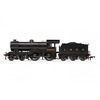=== This product has been discontinued ===
Hornby -
This item appears to not currently be in stock
Hornby - LNER Class D16 8825
This item appears to not currently be in stock
RRP £109.99 , Was £90.00 , Now £81.00
The Class D16/3 locomotives were a derivative of a locomotive reputedly designed by James Holden, CME of the GER but commonly believed to be the work of his Chief Draughtsman at the Stratford Works, Frederick V. Russell. The original locomotive was numbered 1900 after the year that it was built and named “Claud Hamilton” after the then Lord Claud Hamilton (1843–1925), the chairman of the Great Eastern Railway. The “Claud Hamilton” was exhibited at the 1900 Paris Exhibition and was awarded a gold medal.
The 4-4-0 wheel configured locomotive was quickly followed by an order for an additional forty locomotives which were built between the years of 1900 and 1903 and were classified by the GER as S46 (later to be classified as LNER D14s) but very quickly became known as “Clauds”. Soon after these S46, further batches were producedRRP £109.99 , Was £90.00 , Now £81.00
The Class D16/3 locomotives were a derivative of a locomotive reputedly designed by James Holden, CME of the GER but commonly believed to be the work of his Chief Draughtsman at the Stratford Works, Frederick V. Russell. The original locomotive was numbered 1900 after the year that it was built and named “Claud Hamilton” after the then Lord Claud Hamilton (1843–1925), the chairman of the Great Eastern Railway. The “Claud Hamilton” was exhibited at the 1900 Paris Exhibition and was awarded a gold medal.
The 4-4-0 wheel configured locomotive was quickly followed by an order for an additional forty locomotives which were built between the years of 1900 and 1903 and were classified by the GER as S46 (later to be classified as LNER D14s) but very quickly became known as “Clauds”. Soon after these S46, further batches were produced between the years of 1904 – 1911 and were fitted with Belpaire boilers and classified as D56 (later to become D15s). The final batch of ten engines, this time classified by the GER as H88, later to become LNER D16s, were built in 1923 and fitted with 5’ 1” diameter superheated Belpaire boilers and were aptly named “Super Clauds”.
In total 121 of these variants on the original locomotive were built with some 117 being transferred to British Railways in 1948. Prior to this there was a tremendous amount of rebuilding visited on the Class. The D15 locomotives were the residue of the original D15s, plus the earlier D14 engines, which had been rebuilt with Belpaire boilers. Many of these locomotives were later rebuilt as D16/2s and D16/3s. Any remaining locomotives in this group were converted to D15/2s and but simply known as D15s.
The classification D16/1 was given to the original D16 locomotives, which had short smoke boxes but were all rebuilt later with longer smoke boxes and given the Class number D16/2. Those D16 locomotives built in 1923 (Super Clauds) together with certain rebuilt D15 Class locomotives also became part of the Class D16/2, however many were later rebuilt and classed as D16/3s with some being rebuilt in BR days. In short the D16/3 engines (Rebuilt Clauds) were introduced by Sir Nigel Gresley in 1933 and were rebuilds of D14, D15, and D16/2 engines with superheated round topped boilers plus other mechanical and cosmetic changes. By 1949 a total of 104 D16/3s had been rebuilt and proved to be efficient and equal to the earlier variants of the B12 locomotives.
When first introduced the “Clauds” were the largest and most powerful locomotives on the GER and were used on the express routes of the region. At Grouping in 1923 the Clauds were allocated across the Eastern region with one on shed at Doncaster but the vast majority were based at Stratford, Ipswich and Cambridge. From the 1932 “Clauds” were used extensively for passenger work from Cambridge to London, which continued until 1938.
As previously mentioned total of 117 Clauds survived into Nationalisation in 1948, of which fourteen were D15s however the remaining D15s and D16/2s were quickly withdrawn.
The withdrawal of the D16/3s actually commenced in 1945 but during this time the Clauds were still being used quite extensively on the Eastern region. In 1949 eight Clauds were allocated to the Cheshire Lines where exLNER preferred the familiar workings of this type of locomotive than the less familiar LMS engines.
Spares for the D16/3 locomotives began to become a problem and by 1955 a more concerted programme of withdrawal of the Class commenced with No. 62613 being the last to be withdrawn in September 1960.
Originally built as a Class D56 (LNER Class D15) Locomotive 1825 first went to traffic in December 1909. After Grouping the locomotive’s number was changed to 8825 in 1925 and then again in 1942 when the number was changed to 7695. By this time the classification of the locomotive had been changed to D16/3. In April 1942 the number was changed once more to 2576 and finally to 62576 after Nationalisation in 1948.
The first shed that the locomotive was based at was Norwich but by the time the locomotive was withdrawn from service in September 1957, 62576 was on shed at 31A Cambridge.
Locomotive 62576, formerly 8825 was eventually scrapped at the BR Stratford Works in October 1957.
Suitable rolling stock: R4572, R4573, R4574, R4518A
The Class D16/3 locomotives were a derivative of a locomotive reputedly designed by James Holden, CME of the GER but commonly believed to be the work of his Chief Draughtsman at the Stratford Works, Frederick V. Russell. The original locomotive was numbered 1900 after the year that it was built and named “Claud Hamilton” after the then Lord Claud Hamilton (1843–1925), the chairman of the Great Eastern Railway. The “Claud Hamilton” was exhibited at the 1900 Paris Exhibition and was awarded a gold medal.
The 4-4-0 wheel configured locomotive was quickly followed by an order for an additional forty locomotives which were built between the years of 1900 and 1903 and were classified by the GER as S46 (later to be classified as LNER D14s) but very quickly became known as “Clauds”. Soon after these S46, further batches were producedRRP £109.99 , Was £90.00 , Now £81.00
The Class D16/3 locomotives were a derivative of a locomotive reputedly designed by James Holden, CME of the GER but commonly believed to be the work of his Chief Draughtsman at the Stratford Works, Frederick V. Russell. The original locomotive was numbered 1900 after the year that it was built and named “Claud Hamilton” after the then Lord Claud Hamilton (1843–1925), the chairman of the Great Eastern Railway. The “Claud Hamilton” was exhibited at the 1900 Paris Exhibition and was awarded a gold medal.
The 4-4-0 wheel configured locomotive was quickly followed by an order for an additional forty locomotives which were built between the years of 1900 and 1903 and were classified by the GER as S46 (later to be classified as LNER D14s) but very quickly became known as “Clauds”. Soon after these S46, further batches were produced between the years of 1904 – 1911 and were fitted with Belpaire boilers and classified as D56 (later to become D15s). The final batch of ten engines, this time classified by the GER as H88, later to become LNER D16s, were built in 1923 and fitted with 5’ 1” diameter superheated Belpaire boilers and were aptly named “Super Clauds”.
In total 121 of these variants on the original locomotive were built with some 117 being transferred to British Railways in 1948. Prior to this there was a tremendous amount of rebuilding visited on the Class. The D15 locomotives were the residue of the original D15s, plus the earlier D14 engines, which had been rebuilt with Belpaire boilers. Many of these locomotives were later rebuilt as D16/2s and D16/3s. Any remaining locomotives in this group were converted to D15/2s and but simply known as D15s.
The classification D16/1 was given to the original D16 locomotives, which had short smoke boxes but were all rebuilt later with longer smoke boxes and given the Class number D16/2. Those D16 locomotives built in 1923 (Super Clauds) together with certain rebuilt D15 Class locomotives also became part of the Class D16/2, however many were later rebuilt and classed as D16/3s with some being rebuilt in BR days. In short the D16/3 engines (Rebuilt Clauds) were introduced by Sir Nigel Gresley in 1933 and were rebuilds of D14, D15, and D16/2 engines with superheated round topped boilers plus other mechanical and cosmetic changes. By 1949 a total of 104 D16/3s had been rebuilt and proved to be efficient and equal to the earlier variants of the B12 locomotives.
When first introduced the “Clauds” were the largest and most powerful locomotives on the GER and were used on the express routes of the region. At Grouping in 1923 the Clauds were allocated across the Eastern region with one on shed at Doncaster but the vast majority were based at Stratford, Ipswich and Cambridge. From the 1932 “Clauds” were used extensively for passenger work from Cambridge to London, which continued until 1938.
As previously mentioned total of 117 Clauds survived into Nationalisation in 1948, of which fourteen were D15s however the remaining D15s and D16/2s were quickly withdrawn.
The withdrawal of the D16/3s actually commenced in 1945 but during this time the Clauds were still being used quite extensively on the Eastern region. In 1949 eight Clauds were allocated to the Cheshire Lines where exLNER preferred the familiar workings of this type of locomotive than the less familiar LMS engines.
Spares for the D16/3 locomotives began to become a problem and by 1955 a more concerted programme of withdrawal of the Class commenced with No. 62613 being the last to be withdrawn in September 1960.
Originally built as a Class D56 (LNER Class D15) Locomotive 1825 first went to traffic in December 1909. After Grouping the locomotive’s number was changed to 8825 in 1925 and then again in 1942 when the number was changed to 7695. By this time the classification of the locomotive had been changed to D16/3. In April 1942 the number was changed once more to 2576 and finally to 62576 after Nationalisation in 1948.
The first shed that the locomotive was based at was Norwich but by the time the locomotive was withdrawn from service in September 1957, 62576 was on shed at 31A Cambridge.
Locomotive 62576, formerly 8825 was eventually scrapped at the BR Stratford Works in October 1957.
Suitable rolling stock: R4572, R4573, R4574, R4518A
DCC Ready - 8 Pin
Gauge - 00
Manufacturer : Hornby
SKU : R3233
EAN : 5010963432331
SKU : R3233
EAN : 5010963432331


